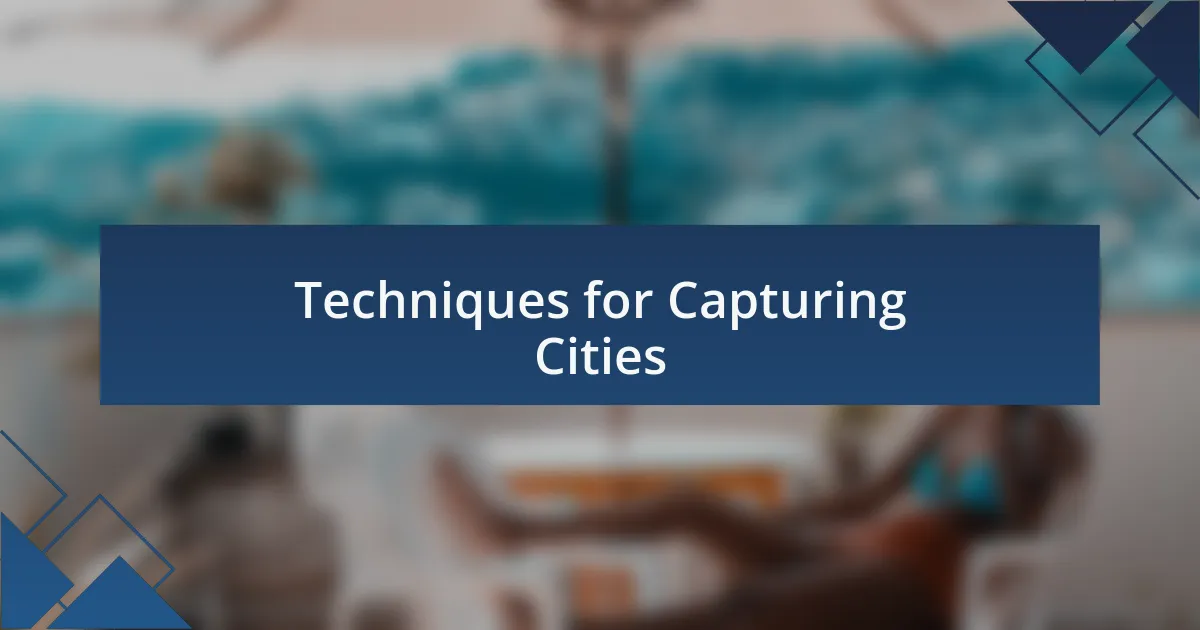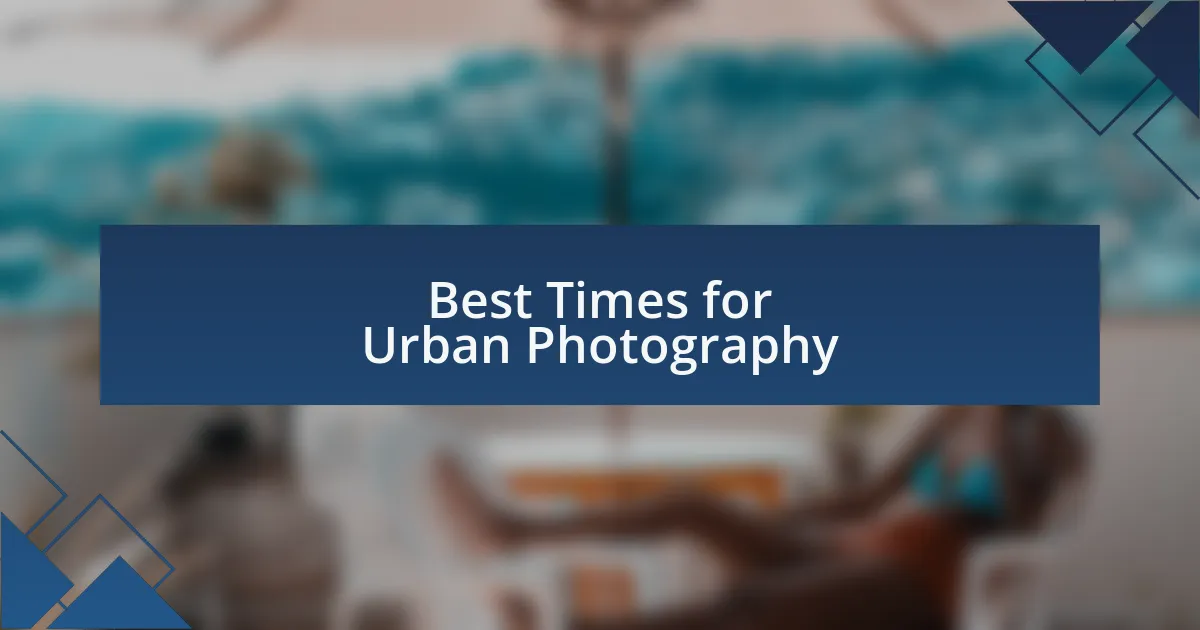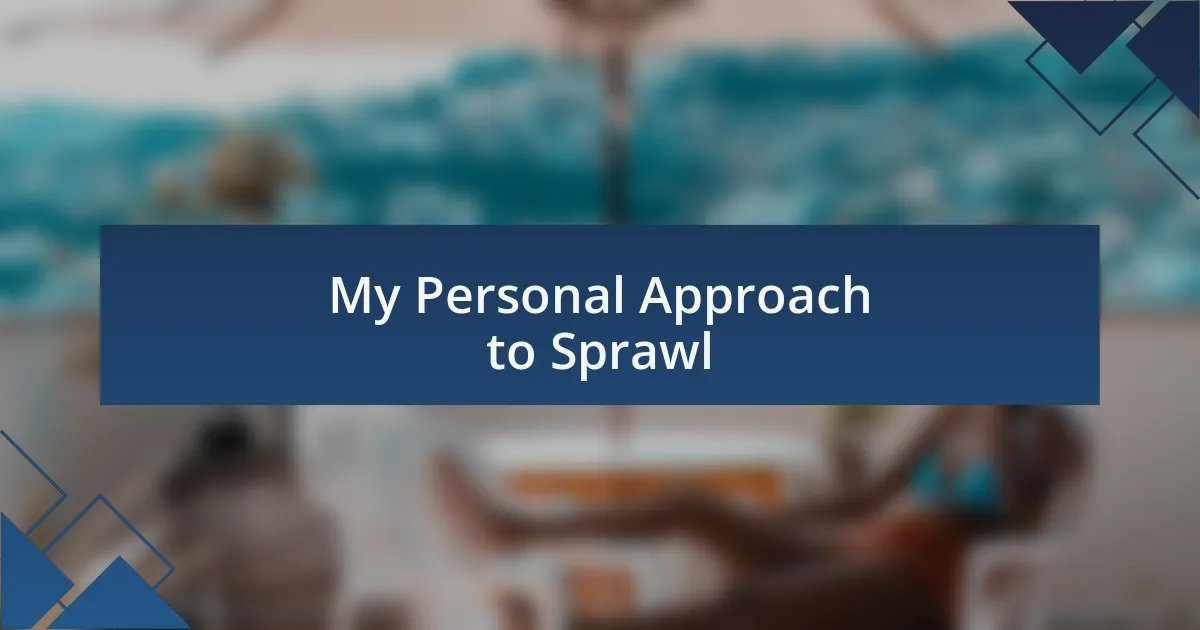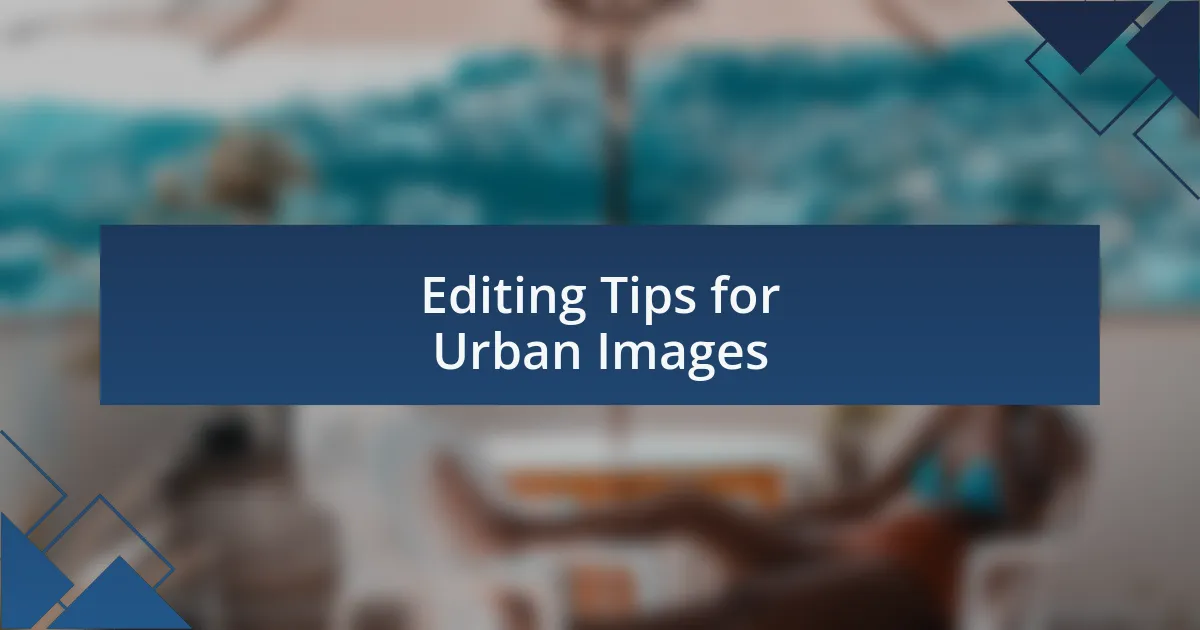Key takeaways:
- Urban sprawl reshapes communities, creating a mix of cultures and narratives that reflect the lives of residents.
- Travel photography is a storytelling tool that highlights the beauty and challenges of diverse cultures, encouraging mindfulness in experiencing the world.
- Timing and perspective are crucial in urban photography, with optimal moments including twilight and early mornings to capture unique atmospheres.
- Editing plays a vital role in enhancing urban images, where adjustments such as contrast, saturation, and cropping can significantly alter the narrative and emotional impact of a photograph.

Understanding Urban Sprawl
Urban sprawl refers to the unchecked spread of cities into surrounding rural areas, fundamentally reshaping landscapes and communities. I often find myself reflecting on this phenomenon while touring places that showcase both the beauty and the chaos of urban development. Have you ever noticed how a once-peaceful farmland transforms into a sprawling suburb overnight?
In my travels, I’ve seen the contrast between vibrant city centers and the hollow suburbs that spread out like veins. It evokes a mix of awe and melancholy when I capture a photo that tells a story of abandoned lots surrounded by shiny new homes. How do these seemingly alien spaces affect our sense of community?
Urban sprawl isn’t just about land use; it’s also about the people living within it. Each sprawl has its own unique character, shaped by the diverse lives of its residents. I remember visiting a neighborhood that was a patchwork of cultures, perfectly illustrating how each layer of development carries its own narrative. What stories are hidden in those sprawling blocks? It’s fascinating to think about the connections and divides that urban sprawl creates.

Importance of Travel Photography
Travel photography serves as a powerful medium for storytelling, capturing moments that would otherwise fade into memory. Every image I take, whether it’s of bustling streets or quiet corners, holds the potential to evoke emotions and provoke thought. Have you ever looked at a photograph and felt transported back in time, as if you could almost hear the sounds and sense the atmosphere of that place?
For me, travel photography is also about advocacy. It draws attention to the beauty and diversity of cultures while shedding light on the challenges these communities face. I recall snapping a picture of a family standing proudly in front of their food stall, with the faded background of their city telling a more complicated tale. How often do we pause to consider the stories behind the vibrant faces we encounter during our journeys?
Moreover, in an age where quick digital consumption often overshadows meaningful experiences, travel photography encourages mindfulness in how we witness the world around us. Each shot becomes a personal reflection, a reminder to appreciate the little things that bring destinations to life. Isn’t it remarkable how a simple click can capture something profound, inviting viewers to see through my eyes and encouraging them to explore the world more compassionately?

Techniques for Capturing Cities
When it comes to capturing cities, perspective is everything. I often look for elevated viewpoints, like rooftops or hills, to convey the sprawling nature of urban landscapes. Have you ever stood at the edge of a city and gazed out, feeling both small and part of something much larger? That’s the sensation I aim to capture—a vast tapestry of life.
Lighting plays a crucial role in my photography. I find that the golden hour, shortly after sunrise or before sunset, bathes the city in a soft, warm glow that adds depth to the buildings and streets. During one of my trips, I vividly remember capturing a city square transformed by the evening light, where the hustle of the day quietly transitioned into the warm chatter of nighttime gatherings. Isn’t it amazing how different a place can feel based on the time of day?
I also love to focus on the details that tell a story—textured walls, colorful street art, or the way shadows interplay with structures. On a recent stroll through a vibrant neighborhood, I encountered an old mural that served as a reminder of the community’s history. It struck me how each crack and color told a part of the city’s evolution. This approach invites viewers to look closer, to appreciate the myriad stories embedded within every cityscape. What stories do you think can be uncovered in the places you visit?

Best Times for Urban Photography
Capturing the essence of urban environments truly depends on timing. I’ve found that twilight, that magical cusp between day and night, creates an ethereal urban landscape. As the city lights flicker on, those first hints of artificial illumination begin to mingle with the fading sunlight, offering a stunning contrast that adds a layer of mystique to my images. Can you feel the magic in the air during that time?
Another ideal moment for photography is during inclement weather. I will never forget one rainy afternoon in a bustling city; the streets were slick with water, reflecting the skyline like a mirror. It felt like the world was transformed, each drop creating a rhythm that was almost musical. Have you ever explored a city while it drizzled? The atmosphere changes entirely, and the people seem more contemplative, almost introspective. There’s a richness in this mood that can evoke powerful emotions.
Finally, don’t overlook the early morning hours when the city is just waking up. I’ve wandered through quiet streets where the hustle and bustle haven’t yet begun, and everything feels untouched. The stillness often allows me to capture candid moments, like a lone jogger or a vendor setting up shop. It’s in these quieter moments that you can truly hear a city come to life. What stories do you think those early risers hold in the waking hours?

Choosing the Right Equipment
Choosing the right equipment is crucial for capturing the sprawling dynamics of urban landscapes. I’ve learned that a good camera with versatile lens options can significantly influence the outcome of your shots. For instance, a wide-angle lens has been my go-to for capturing the expanse of a skyline, allowing me to include both the dramatic architecture and the bustling streets below. Do you remember the last time you were awed by a cityscape? The right lens can enhance that awe.
When it comes to tripods, I can’t stress enough how vital stabilization is in the urban jungle. During a recent adventure, I set up my tripod in a busy square just as the sun dipped below the horizon. The stability allowed me to play with longer exposures, capturing vibrant motion blur from passing cars and pedestrians, which added a sense of life to the stillness of the city. Have you ever tried experimenting with motion in your photos? The results can be electrifying.
Beyond cameras and lenses, I find that carrying a lightweight backpack filled with essential accessories is a game-changer. Spare batteries and memory cards are non-negotiable. I once ran out of battery as the perfect golden hour approached, leaving me frustrated and missing out on some incredible shots. How often do we really think about the unexpected? Preparation not only saves time but also opens up the possibility for spontaneous moments that define urban photography.

My Personal Approach to Sprawl
When I venture into sprawl, I tend to immerse myself in the city’s rhythms. One afternoon, I wandered through a lesser-known neighborhood, camera in hand, and stumbled upon an unexpected mural that told a story of the community’s history. It struck me how urban sprawl often hides these gems, waiting for curious eyes to uncover them. Have you ever felt that surge of excitement when you discover something unique in a familiar setting?
Another aspect I embrace is capturing the contrasts within urban sprawl. During a recent shoot, I found myself perched on a rooftop, watching the sun set over skyscrapers while the streets below bustled with life. The juxtaposition between the towering buildings and the small, family-owned shops caught my attention. It made me ponder: how do these different layers coexist? I believe such contrasts tell more profound stories about a city’s identity.
Finally, I often reflect on the emotional weight of sprawl. The expanse can be isolating yet vibrant at the same time. On a quiet evening, I observed people lost in their own worlds, juxtaposed against sprawling neon lights. It reminded me of a poem I once read about solitude in crowds. Moments like these inspire me to capture not just what I see but also the feelings that linger in the air—making each shot a narrative beyond the frame.

Editing Tips for Urban Images
Editing urban images is a delicate dance between enhancing the city’s vibrancy and preserving its authenticity. I remember a time when I edited a photo from a gritty alleyway; I decided to emphasize the graffiti’s colors while keeping the shadows intact. This choice highlighted the raw energy of the place. Have you ever noticed how a little adjustment can turn an ordinary shot into something extraordinary?
When it comes to urban photography, I often play with contrast and saturation. On one occasion, I took a photo of a busy crosswalk at dusk. By subtly boosting the saturation, the neon lights really popped against the night sky, creating a more dynamic feel. It made the image jump out, drawing the viewer into the chaos and beauty of city life. Isn’t it fascinating how a few tweaks can breathe life into an image?
Lastly, don’t underestimate the power of cropping. I once captured a sprawling cityscape, but it felt overwhelming. So, I decided to crop in on a particular section, exposing just a couple of buildings framed against the setting sun. The result was a more intimate portrayal that encouraged viewers to explore the stories behind those structures. Have you ever found that changing your frame can completely shift the narrative? It’s truly surprising what an edit can do!